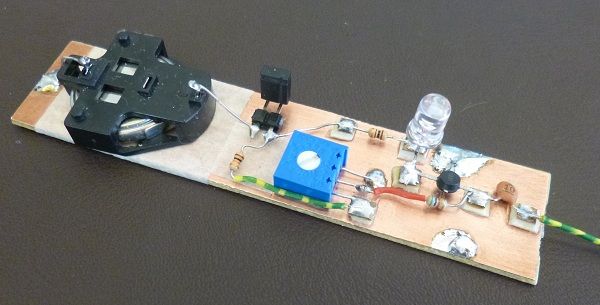Summary of VHF-UHF RF Sniffer
This article introduces a simple RF sniffer circuit designed for testing a 433 MHz UHF transmitter by visualizing its operation through an LED indicator. It helps confirm if the transmitter oscillator is working, estimates output power via LED brightness, and measures oscillator frequency using a Lecher line method. The article highlights challenges with UHF frequencies where circuit layout critically affects performance, advising against solderless breadboards due to parasitic effects and emphasizing the use of a common ground plane. It also discusses typical component characteristics for UHF circuits, such as small inductors, short antennas, and low-value capacitors.
Parts used in the RF Sniffer Circuit:
- LED
- Copper wire (for Lecher lines)
- Air-core inductors (low value)
- Capacitors (low value)
- Common ground plane PCB (double-sided)
- Basic RF transistor or oscillator components (not detailed)
This is a multi-chapter instructable. I will be describing the making of a short/medium range RF remote-control using the UHF 433Mhz frequency. It´s impossible to setup & adjust a RF transmit-receive link if you are not sure the transmitter is working properly.At 433MHz, your multimeter or even a regular oscilloscope are totally useless.

In this chapter (1) I will show you this ultra-simple RF sniffer circuit with which you can visualize with an LED:
(1) if the transmitter is oscillating.
(2) its relative power output by the brightness of LED.
(3) check the frequency of the oscillator with a simple school ruler by measuring the distance between nodes (as did Ernst Lecher 120 years ago ) https://en.wikipedia.org/wiki/Lecher_lines .At 433MHz, distance between nodes (0-crossing points) is 323mm on copper wire (half wavelength).
UHF comprises frequencies between 300Mhz and 3Ghz. At these frequencies the physical layout of the components is crucial; the same circuit may work or not depending on how it´s built. A single millimeter of wire or component lead is an inductor and affects the circuit. You cannot use a solderless breadboard because it´s plagued with parasitic capacitances and inductances which at UHF frequencies (and VHF) behave as actual components. To avoid crosstalk between traces & ground loops UHF circuit must share a common ground plane (eg:,double sided PCB) to which all ground points are connected ( https://en.wikipedia.org/wiki/Ground_plane ).
On the good side, UHFinductors are of low values and are usually air-core and made with few turns of wire or even printed on the PCB. The same applies for antennas: at 433Mhz a 1/4 wave antenna is only 17cm long. Capacitor values are also very low. All these properties translate into a very small & economical circuit.
For more detail: VHF-UHF RF Sniffer

In this chapter (1) I will show you this ultra-simple RF sniffer circuit with which you can visualize with an LED:
(1) if the transmitter is oscillating.
(2) its relative power output by the brightness of LED.
(3) check the frequency of the oscillator with a simple school ruler by measuring the distance between nodes (as did Ernst Lecher 120 years ago ) https://en.wikipedia.org/wiki/Lecher_lines .At 433MHz, distance between nodes (0-crossing points) is 323mm on copper wire (half wavelength).
UHF comprises frequencies between 300Mhz and 3Ghz. At these frequencies the physical layout of the components is crucial; the same circuit may work or not depending on how it´s built. A single millimeter of wire or component lead is an inductor and affects the circuit. You cannot use a solderless breadboard because it´s plagued with parasitic capacitances and inductances which at UHF frequencies (and VHF) behave as actual components. To avoid crosstalk between traces & ground loops UHF circuit must share a common ground plane (eg:,double sided PCB) to which all ground points are connected ( https://en.wikipedia.org/wiki/Ground_plane ).
On the good side, UHFinductors are of low values and are usually air-core and made with few turns of wire or even printed on the PCB. The same applies for antennas: at 433Mhz a 1/4 wave antenna is only 17cm long. Capacitor values are also very low. All these properties translate into a very small & economical circuit.
For more detail: VHF-UHF RF Sniffer
